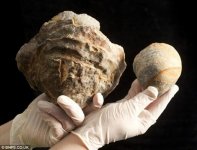Adeline Leigh
New Member
This might interest some of us...
=====================
The 100-million-year-old oyster, ten times the normal size, which will undergo MRI scan to see if it contains the world's biggest pearl
By Eddie Wrenn
PUBLISHED: 10:32 GMT, 5 June 2012 | UPDATED: 12:52 GMT, 5 June 2012
A gigantic oyster fossil that was accidentally trawled up by fishermen is to be MRI-scanned to see if it contains an enormous pearl.
The prehistoric mollusc is more than 100million years old and is ten times bigger than a regular oyster shell.
It was hauled up in the Solent and found in the nets of the trawler boat when it returned to port.
After layers of mud were washed off, it was clear the item was a huge fossilised shell that measured seven inches wide and three inches
A shell of this size could be concealing a pearl the size of a golf ball, dwarfing the average 7mm diametre size of an oyster pearl.
Such a gem would be worth thousands and thousands of pounds.
The oyster has been given to the Blue Reef Aquarium in Portsmouth, Hampshire, where experts there have managed to date it by studying its growth rings, much like a tree.
They are now waiting to have it MRI scanned to see if it holds the rare pearl.
A spokesman from the Blue Reef Aquarium said: 'It was discovered in the nets of a fishing boat which was dredging here in the Solent.
'When the fishermen came back to port they thought it was real, but when they picked it up, cleaned it, and had a closer look they could tell it was a fossil.
'It had completely turned to stone.
'A member of the public called and informed us it was on display at a local fishmongers so we called them and they gave it to us to have in the aquarium.
'Oysters can be aged by annual growth rings on their shells and we have counted more than 200 rings on this oyster making it an extremely long-lived individual.
'It's obviously a million-to-one chance that it would contain anything but, if you were to go purely on the dimensions of the shell then you'd be looking at a golf ball-sized pearl.
'We are hoping to have it MRI scanned in the near future to see if it is concealing something.'
Caption 1:
Bigger on the inside: Aquarist Jenna MacFarlane from the Blue Reef Aquarium holds the gigantic oyster could it contain the world's biggest pearl.
Caption 2:
Overgrown: The Jurassic monster is displayed next to a normal oyster. The prehistoric mollusc is more than 100million years old
Read more: http://www.dailymail.co.uk/sciencet...tains-worlds-biggest-pearl.html#ixzz1wvwqCKM1
Read more: http://www.dailymail.co.uk/sciencet...tains-worlds-biggest-pearl.html#ixzz1wvwhR6rK
Read more: http://www.dailymail.co.uk/sciencet...tains-worlds-biggest-pearl.html#ixzz1wvwJIMRv
=====================
The 100-million-year-old oyster, ten times the normal size, which will undergo MRI scan to see if it contains the world's biggest pearl
By Eddie Wrenn
PUBLISHED: 10:32 GMT, 5 June 2012 | UPDATED: 12:52 GMT, 5 June 2012
A gigantic oyster fossil that was accidentally trawled up by fishermen is to be MRI-scanned to see if it contains an enormous pearl.
The prehistoric mollusc is more than 100million years old and is ten times bigger than a regular oyster shell.
It was hauled up in the Solent and found in the nets of the trawler boat when it returned to port.
After layers of mud were washed off, it was clear the item was a huge fossilised shell that measured seven inches wide and three inches
A shell of this size could be concealing a pearl the size of a golf ball, dwarfing the average 7mm diametre size of an oyster pearl.
Such a gem would be worth thousands and thousands of pounds.
The oyster has been given to the Blue Reef Aquarium in Portsmouth, Hampshire, where experts there have managed to date it by studying its growth rings, much like a tree.
They are now waiting to have it MRI scanned to see if it holds the rare pearl.
A spokesman from the Blue Reef Aquarium said: 'It was discovered in the nets of a fishing boat which was dredging here in the Solent.
'When the fishermen came back to port they thought it was real, but when they picked it up, cleaned it, and had a closer look they could tell it was a fossil.
'It had completely turned to stone.
'A member of the public called and informed us it was on display at a local fishmongers so we called them and they gave it to us to have in the aquarium.
'Oysters can be aged by annual growth rings on their shells and we have counted more than 200 rings on this oyster making it an extremely long-lived individual.
'It's obviously a million-to-one chance that it would contain anything but, if you were to go purely on the dimensions of the shell then you'd be looking at a golf ball-sized pearl.
'We are hoping to have it MRI scanned in the near future to see if it is concealing something.'
Caption 1:
Bigger on the inside: Aquarist Jenna MacFarlane from the Blue Reef Aquarium holds the gigantic oyster could it contain the world's biggest pearl.
Caption 2:
Overgrown: The Jurassic monster is displayed next to a normal oyster. The prehistoric mollusc is more than 100million years old
Read more: http://www.dailymail.co.uk/sciencet...tains-worlds-biggest-pearl.html#ixzz1wvwqCKM1
Read more: http://www.dailymail.co.uk/sciencet...tains-worlds-biggest-pearl.html#ixzz1wvwhR6rK
Read more: http://www.dailymail.co.uk/sciencet...tains-worlds-biggest-pearl.html#ixzz1wvwJIMRv


